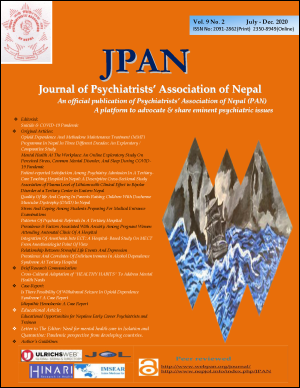Prevalence And Correlates Of Delirium tremens In Alcohol Dependence Syndrome At Tertiary Hospital
DOI:
https://doi.org/10.3126/jpan.v9i2.36288Keywords:
Alcohol withdrawal syndrome, clinical variables, Delirium tremens, socio-demographic variablesAbstract
Introduction: The prevalence of Delirium tremens (DT) is around 5-12%. Very few studies have looked into the prevalence of DT in general population and has shown varying results. The study aims at finding the prevalence of delirium tremens among alcohol dependents (AD) and a comparison of profiles of alcohol withdrawal syndrome (AWS) with DT and AWS without DT.
Material And Method: A case- control study was conducted in patients diagnosed as Alcohol dependent syndrome and admitted in Psychiatry in-patient ward for detoxification. Socio demographic and clinical variables were assessed and compared between alcohol dependents who developed DT and who did not developed DT.
Results: 24% of the patients with AD had/developed delirium tremens. The multivariate regression analysis model shows variables like Age>50years (AOR= 75.7,95% C.I=7.8-730), Caste(Janjati: AOR=4.2, 95% C.I=1.329-13.23,) and unemployment(AOR=54.2, 95%C.I=3.8-765.254),longer length(years) of alcohol consumption >20 years(AOR= 305,95%CI=3.4-2711),presentation within 48-72 hrs since the last intake of alcohol (AOR=923,95%CI=38-22333),absence of nicotine consumption(AOR=40,95%C.I.=1.66-967) were significantly associated with development of delirium tremens. Similarly, those with educational status of higher secondary and above (AOR=0.7, 95% C.I =0.73-1.43), past history of absence of DT (AOR=0.013, 95% C.I=0.0002-0.77), less frequent intake of alcohol <3 times/week (AOR=0.001,95%C.I=0.001-0.07) had less likely developed DT. These significant variables were further assessed for their ability to predict the occurrence of delirium tremens in ROC and area under the curve for age, duration since last alcohol intake and years of intake of alcohol were respectively = 0.799, 0.843 and 0.765.
Conclusion: Three features findings (older Age, more years of intake of alcohol, more hrs since last intake of alcohol) were more likely seen in delirium tremens patients.
Downloads
Downloads
Published
How to Cite
Issue
Section
License
This license enables reusers to distribute, remix, adapt, and build upon the material in any medium or format, so long as attribution is given to the creator. The license allows for commercial use.




